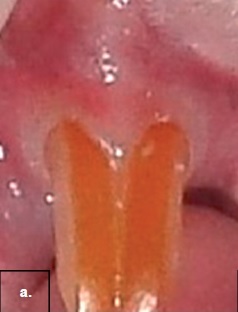Oral mucosa analog allografts in non-consanguineous rats
Abstract
Introduction: Although there are therapeutic options for the treatment of oral mucosa defects, the need for functional, anatomical and aesthetically similar substitutes persists, as well as for solutions to reduce autologous grafts morbidity.
Objective: To determine clinical and histological compatibility of equivalent oral mucosa allografts generated through tissue engineering in non-consanguineous rats.
Materials and methods: We used a sample of oral mucosa from Sprague Dawley rats to obtain a fibroblast culture and a keratinocytes and fibroblasts co-culture. In both cases, we used a commercial collagen membrane as “scaffold”. After ten weeks of culture, we grafted the resulting membranes into four Wistar rats. The first phase of the study was the development of the oral mucosa equivalents generated by tissue engineering. Then, we implanted them in immunocompetent Wistar rats, and finally
we evaluated the clinical and histological features of the allografts.
Results: In vivo evaluation of mucosal substitutes showed a correct integration of artificial oral mucosa in immunocompetent hosts, with an increase in periodontal biotype and the creation of a zone with increased keratinization. Histologically, the tissue was similar to the control oral mucosa sample with no inflammatory reaction nor clinical or histological rejection signs.
Conclusion: The equivalent oral mucosa allografts generated by tissue engineering showed clinical and histological compatibility.
Downloads
References
Bello SA, Peña J, Estrada LE, Fontanilla MR. Sustitutos de mucosa oral creados mediante ingeniería tisular. Una alternativa para la reconstrucción de defectos de mucosa oral. Rev CES Odont. 2001;14:55-64.
Liu J, Bian Z, Kuijpers A, Von J. Skin and oral mucosa equivalents: Construction and performance. Orthod Craniofac Res. 2010;13:11-20. http://dx.doi.org/10.1111/j.1601-6343. 2009.01475.x
Marañés C, Liceras E, Alaminos M, Fernández R, Ruiz AM, Garzón I, et al. Generación de un sustituto de mucosa oral humana y comprobación de su viabilidad mediante ingeniería tisular. Cir Pediatr. 2011;24:13-18.
Scheyer ET, Nevins ML, Neiva R, Cochran DL, Giannobile WV, Woo SB, et al. Generation of site-appropriate tissue by a living cellular sheet in the treatment of mucogingival defects. J Periodontol. 2014;85:57-64. http://dx.doi.org/10.1902/jop.2013.130348
Liu J, Mao JJ, Chen L. Epithelial–mesenchymal interactions as a working concept for oral mucosa regeneration. Tissue Eng Part B Rev. 2011;17:25-31. http://dx.doi.org/10.1089/ten.TEB.2010.0489
Abbas K, Lichtman A, Pober J. Inmunología celular y molecular. Segunda edición. Madrid: Interamericana - McGraw Hill; 1995. p. 1181.
Padrón K, Salmen S, Berrueta L, González E, Dávila L, Rojas J, et al. Purificación de fibroblastos gingivales a partir de tejido de la mucosa bucal. Avances en Biomedicina. 2012;1:4-8.
Lenas P, Moos M, Luyten FP. Developmental engineering: A new paradigm for the design and manufacturing of cellbased products. Part I: From three-dimensional cell growth to biomimetics of in vivo development. Tissue Eng Part B Rev. 2009;15:381-94. http://dx.doi.org/10.1089/ten.TEB.2008.0575
Espinosa L. Desempeño de sustitutos artificiales de tejido como injertos en heridas de mucosa oral de conejo y evaluación in vitro de su papel quimiotáctico. Tesis doctoral. Bogotá, D.C.: Universidad Nacional de Colombia; 2011.
Izumi K, Feinberg SE. Skin and oral mucosal substitutes. Oral Maxillofac Surg Clin North Am. 2002;14:61-71. http://dx.doi.org/10.1016/S1042-3699(02)00010-9
Raguse JD, Gath HJ. A metabolically active dermal replacement (Dermagraft) for vestibuloplasty. J Oral Rehabil. 2005;32:337-40. http://dx.doi.org/10.1111/j.1365-2842.2004.01430.x
Cañadas LM. Caracterización histológica de mucosa oral de espesor completo obtenida mediante ingeniería tisular. Tesis doctoral. Granada: Universidad de Granada; 2006.
Tsai CY, Ueda M, Hata K, Horie K, Hibino Y, Sugimura Y, et al. Clinical results of cultured epithelial cell grafting in the oral and maxilofacial region. J Craniomaxillofac Surg. 1997;25:4-8.
http://dx.doi.org/10.1016/S1010-5182 (97)80017-0 14. Thoma DS, Benic GI, Zwahlen M, Hammerle CH, Jung RE. A systematic review assessing soft tissue augmentation techniques. Clin Oral Implants Res. 2009;20:146-65. http://dx.doi.org/10.1111/j.1600-0501.2009.01784.x
Novaes AB, Marchesan JT, Macedo GO, Palioto DB. Effect of in vitro gingival fibroblast seeding on the in vivo incorporation of acellular dermal matrix allografts in dogs. J Periodontol. 2007;78:296-303. http://dx.doi.org/10.1902/jop.2007.060060
Izumi K, Feinberg SE, Iida A, Yoshizawa M. Intraoral grafting of an ex vivo produced oral mucosa equivalent: A preliminary report. Int J Oral Maxillofac Surg. 2003;32:188-97. http://dx.doi.org/10.1054/ijom.2002.0365
Ophof R.Construction and application of substitutes for oral mucosa in cleft palate repair. Netherlands: Universidad de Nijmegen; 2010.
Garzón IJ. Estudio de marcadores de diferenciación epitelial en mucosa oral construida por ingeniería tisular. Tesis doctoral. Granada: Universidad de Granada; 2009.
Hotta T, Yokoo S, Terashi H, Komori T. Clinical and histopathological analysis of healing process of intraoral reconstruction with ex vivo produced oral mucosa equivalent. Kobe J Med Sci. 2007;53:1-14.
Song J, Izumi K, Lanigan T, Feinberg SE. Development and characterization of a canine oral mucosa equivalent in a serum-free environment. J Biomed Mater Res A. 2004;71:143-53. http://dx.doi.org/10.1002/jbm.a.30144
Olávez D, Sosa L, Padrón K, Salmen S, Berrueta L, Dávila L, et al. Análogo de tejido conectivo a partir de fibroblastos gingivales sembrados en membranas de colágeno comercial. Acta Bioclínica. 2013;5:83-97.
Bayar GR, Aydintug YS, Gulses A, Elci P, Sarper M. A pilot study of the primary culture of the oral mucosa keratinocytes by the direct explant technique. OHDM. 2011;10:88-92.
González S, Junquera L, Peña I, García V, Gallego L, García E, et al. Cultivo in vitro con colágeno y fibroblastos humanos de un equivalente de mucosa oral de espesor total. Rev Esp Cir Oral Maxilofac. 2009;31:98-106.
Bello S, Pereira E, Fontanilla M. Elaboración de tejido conectivo artificial autólogo de mucosa oral y evaluación de su desempeño como cobertura biológica en lesiones mucosas inducidas en conejos. Rev Fed Odontol Colomb. 2004;20:12-28.
González M. Evaluación de la expresión de factores de crecimiento involucrados en la reparación de heridas mucosas en tejido conectivo artificial. Tesis doctoral. Bogotá, D.C.: Universidad Nacional de Colombia; 2011.

| Article metrics | |
|---|---|
| Abstract views | |
| Galley vies | |
| PDF Views | |
| HTML views | |
| Other views | |

























